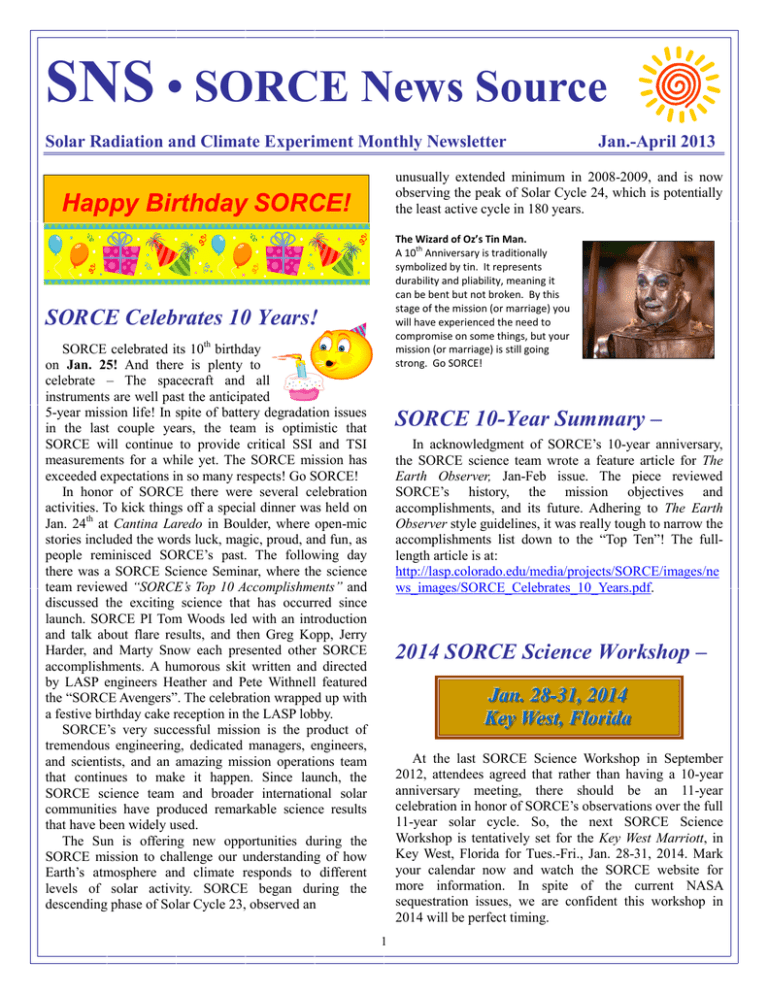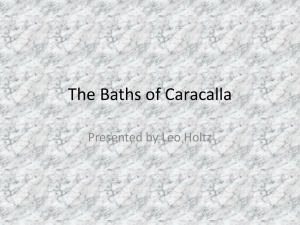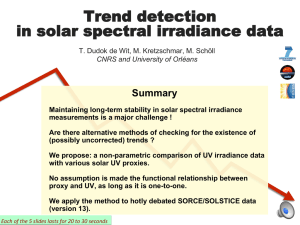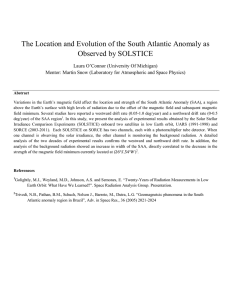SNS • SORCE News Source
advertisement

SNS • SORCE News Source Solar Radiation and Climate Experiment Monthly Newsletter Jan.-April 2013 unusually extended minimum in 2008-2009, and is now observing the peak of Solar Cycle 24, which is potentially the least active cycle in 180 years. Happy Birthday SORCE! The Wizard of Oz’s Tin Man. th A 10 Anniversary is traditionally symbolized by tin. It represents durability and pliability, meaning it can be bent but not broken. By this stage of the mission (or marriage) you will have experienced the need to compromise on some things, but your mission (or marriage) is still going strong. Go SORCE! SORCE Celebrates 10 Years! SORCE celebrated its 10th birthday on Jan. 25! And there is plenty to celebrate – The spacecraft and all instruments are well past the anticipated 5-year mission life! In spite of battery degradation issues in the last couple years, the team is optimistic that SORCE will continue to provide critical SSI and TSI measurements for a while yet. The SORCE mission has exceeded expectations in so many respects! Go SORCE! In honor of SORCE there were several celebration activities. To kick things off a special dinner was held on Jan. 24th at Cantina Laredo in Boulder, where open-mic stories included the words luck, magic, proud, and fun, as people reminisced SORCE’s past. The following day there was a SORCE Science Seminar, where the science team reviewed “SORCE’s Top 10 Accomplishments” and discussed the exciting science that has occurred since launch. SORCE PI Tom Woods led with an introduction and talk about flare results, and then Greg Kopp, Jerry Harder, and Marty Snow each presented other SORCE accomplishments. A humorous skit written and directed by LASP engineers Heather and Pete Withnell featured the “SORCE Avengers”. The celebration wrapped up with a festive birthday cake reception in the LASP lobby. SORCE’s very successful mission is the product of tremendous engineering, dedicated managers, engineers, and scientists, and an amazing mission operations team that continues to make it happen. Since launch, the SORCE science team and broader international solar communities have produced remarkable science results that have been widely used. The Sun is offering new opportunities during the SORCE mission to challenge our understanding of how Earth’s atmosphere and climate responds to different levels of solar activity. SORCE began during the descending phase of Solar Cycle 23, observed an SORCE 10-Year Summary – In acknowledgment of SORCE’s 10-year anniversary, the SORCE science team wrote a feature article for The Earth Observer, Jan-Feb issue. The piece reviewed SORCE’s history, the mission objectives and accomplishments, and its future. Adhering to The Earth Observer style guidelines, it was really tough to narrow the accomplishments list down to the “Top Ten”! The fulllength article is at: http://lasp.colorado.edu/media/projects/SORCE/images/ne ws_images/SORCE_Celebrates_10_Years.pdf. 2014 SORCE Science Workshop – JJaann.. 2288--3311,, 22001144 K Keeyy W Weesstt,, F Flloorriiddaa At the last SORCE Science Workshop in September 2012, attendees agreed that rather than having a 10-year anniversary meeting, there should be an 11-year celebration in honor of SORCE’s observations over the full 11-year solar cycle. So, the next SORCE Science Workshop is tentatively set for the Key West Marriott, in Key West, Florida for Tues.-Fri., Jan. 28-31, 2014. Mark your calendar now and watch the SORCE website for more information. In spite of the current NASA sequestration issues, we are confident this workshop in 2014 will be perfect timing. 1 April 30 to respond to questions and items needing further clarification. The review panel is expected to make a decision on the next SORCE Extended Mission by mid to late June. Instrument Power Cycling – Due to the inevitable degradation of the SORCE spacecraft batteries, the SORCE Mission Operations team has been power cycling all of the SORCE instruments during eclipse times to conserve power and to avoid a battery overload emergency situation. They have been extremely resourceful in maximizing the battery capacity by closely monitoring the daily wear-and-tear and being proactive. The power demands in eclipse are the biggest challenge, but by power cycling all of the instruments and optimizing the battery charge profile during orbit day, the SORCE instruments still acquire observations on a routine basis. So far, all the instruments are performing core science acquisition on the same schedule as before power cycling. Unfortunately important instrument calibration activities are lost in this mode; stellar calibrations for SOLSTICE and dark measurements for TIM are no longer possible. However, with a 10-year calibration record adequate models of SOLSTICE degradation can be extrapolated and the dark measurement model for TIM is still valid. Since the instrument heaters are also off during eclipse, the first few minutes of the solar period are used warming the instruments back up to their normal operating temperatures. Temperature corrections in the data processing algorithms for all of the instruments are more important now than they were at the beginning of the mission. SOLSTICE A and XPS began power cycling in December 2009. SOLSTICE B has been turned off during any eclipse longer than 30 minutes since July 2010. Starting in January 2011, SIM B was also off during eclipse. SIM A began power cycling in May 2011. SOLSTICE B transitioned to power cycling for all eclipses in June 2011, and TIM started power cycling in November 2012. The current mode of operation is still providing accurate solar irradiance observations and is now considered the “normal” mode for the SORCE extended mission. By effective battery management, the science data collected has not been compromised. The mission continues to meet its science goals. At the January 2014 meeting we will be addressing the key results obtained during the SORCE mission. The key results were highlighted in an article published in the January-February issue of NASA’s Earth Observer, referenced above in the SORCE 10-Year Summary story with a link to the full article. SORCE Extended Mission Proposal Submitted – The SORCE team submitted the SORCE Extended Mission Proposal for 2014-2017 in early March. All NASA Earth Science Missions submit proposals for senior review every two years. SORCE has successfully completed its 5-year core mission (Jan. 2003-Jan. 2008) and is currently in the sixth year of its extended mission. It has achieved its primary mission goal of measuring total solar irradiance (TSI) and solar spectral irradiance (SSI) in the 0.1-27 nm and 115-2400 nm wavelength ranges with unprecedented accuracy and precision. The main objectives of the SORCE extended mission are very much aligned with the original SORCE mission objectives, but have new focus with the current state of NASA missions and solar activity in solar cycle 24. The spacecraft battery is the most likely life-limiting factor for the SORCE Mission, so all efforts will be made to ensure that it stays as healthy as possible. With proper management of spacecraft resources, we predict that we can continue making good quality solar irradiance measurements throughout the extended mission timeframe. SORCE is poised for an extended mission out to 2017, and our next-generation TIM and SIM instruments are planned for a launch on a NOAA satellite in 2016. As a follow-up to the written proposal, the SORCE scientists met with the Sr. Review Panel at NASA on 2 2013 REU Students Selected – Erik Richard worked with REU student Lauren Bearden from Colgate University during the summer of 2012. They worked on trends in the short-term SSI variability during the declining phase of SC23. Lauren presented her science results at the 2012 SORCE Meeting in Annapolis last September. By Marty Snow, LASP, Univ. of Colorado As in the past, each summer the SORCE mission funds student research projects as part of the University of Colorado’s Research Experience for Undergraduates (REU) program. For eight weeks, the students come to Boulder, Colorado to work with SORCE scientists on a research project involving measurements from SORCE. The Boulder REU program, led by SOLSTICE instrument scientist Marty Snow, pays for the students’ travel costs and housing, plus a $500/week stipend. Upcoming Meetings / Talks – SORCE scientists plan to present papers or attend the following 2013-2014 meetings/workshops: CALCon, Aug. 19-22, Logan, UT SPIE Optics + Photonics, Aug. 27-29, San Diego, CA SOLID (1st European SOLar Irradiance Data Exploitation), Oct. 14-18, France AGU Fall Meeting, Dec. 9-13, San Francisco, CA SORCE Science Workshop, Jan. 28-31, Key West, FL The 2012 REU students working in Boulder at various locations, flanked by their LASP leaders, Marty Snow (far left) and Erin Wood (far right). Every year the students begin their time at LASP with a lectures series on Solar and Space Physics from experts in the field, and end with a student symposium where the REU students present their findings. Last year, three students worked on a diverse set of projects using SORCE data. This included studying the effect of the visible irradiance variability measured by the SIM instrument, tackling climate change during the recent solar minimum using meteorological datasets and irradiance observations from all of the SORCE instruments, and analyzing SOLSTICE data to measure the properties of the South Atlantic Anomaly. This year’s projects will be just as interesting! There will be a record-breaking 18 students from around the U.S. in the Boulder program, and SORCE is fortunate to be hosting 4 students who will each be given a unique project and a mentor to help them with their individual research project. The students will study the atmospheric response to solar variability, develop a proxy model for solar EUV irradiance, explore climate change, and gain hands-on experience with a small spacecraft (cubesat). Full program details are available at http://lasp.colorado.edu/reu. Happy Spring! 3




